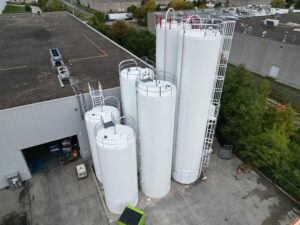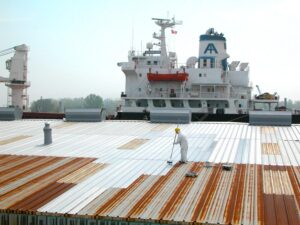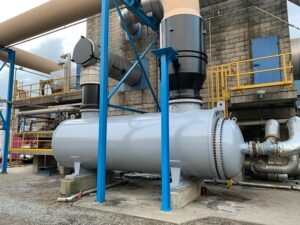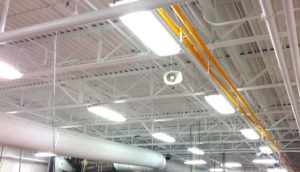Tank lining plays a vital role in preserving the integrity and longevity of storage tanks used in industrial, agricultural, or municipal applications, enhancing tank functionality and operational efficiency. This discussion will explore the numerous benefits of tank lining, such as improved durability, enhanced safety, and cost-effectiveness.
Additionally, it will cover the different types of lining services available, ranging from internal to external applications, including industrial coatings and tank sealing., and offer guidance on selecting the right service provider. Understanding the tank lining process, maintenance protocols, and surface restoration practices is crucial for ensuring optimal performance and corrosion protection. Let us delve into everything you need to know about tank lining.
What is Tank Lining?
Tank lining involves applying protective coatings, such as polyurethane coating, to the internal surfaces of storage tanks, including those used for fuel, wastewater, and chemicals, to enhance their functionality and durability. This process is essential for preventing corrosion, containing fluids, and ensuring compliance with environmental regulations.
Properly installed tank lining systems extend the lifespan of tanks and their associated systems while safeguarding the tanks and the surrounding environment from hazardous materials and contamination risks. from potential leaks and environmental hazards.
Various industries utilize different types of lining materials based on their specific applications. The most common types of tank linings include:
- epoxy, cement lining
- polyethylene, fiberglass lining
- rubber, surface treatment
- glass-fused-to-steel linings
Benefits of Tank Lining
Tank lining offers numerous advantages, significantly enhancing safety measures, operational efficiency, and compliance with environmental regulations, contributing to extended asset longevity.
By utilizing high-quality protective coatings such as epoxy lining and polymer linings, tank systems can achieve improved corrosion resistance, leakage prevention, and enhanced environmental compliance, extending the longevity of the tanks.
These protective linings help minimize tank maintenance costs and increase the overall lifespan of industrial tanks, leading to substantial cost savings and improved tank performance for businesses over time.
Improved Tank Durability and Safety
Enhanced tank durability and safety are significant benefits of effective tank lining systems, including superior abrasion resistance. The application of robust protective coatings, such as anti-corrosive coatings and abrasion-resistant linings, ensures that tanks can endure harsh industrial conditions, thereby maintaining their structural integrity over time.
These improvements not only extend the physical lifespan of the tanks but also help preserve operational safety and prevent hazardous leaks and environmental contamination. In various industrial environments, the proper selection of linings to resist corrosion and protect against physical damage from the harsh chemicals or materials they contain is essential for ensuring regulatory compliance.
Another key advantage of utilizing advanced lining technologies is the reduction of maintenance costs related to repairs and replacements, thereby improving cost-effective solutions. These protective coatings, which resist corrosion and wear, provide a critical barrier that enhances tank performance, improves efficiency, and minimizes contamination risks.
This proactive approach to tank management ensures compliance with regulations designed to protect the environment and enhance the safety of employees and the surrounding community living near operational industrial facilities, through effective contamination prevention.
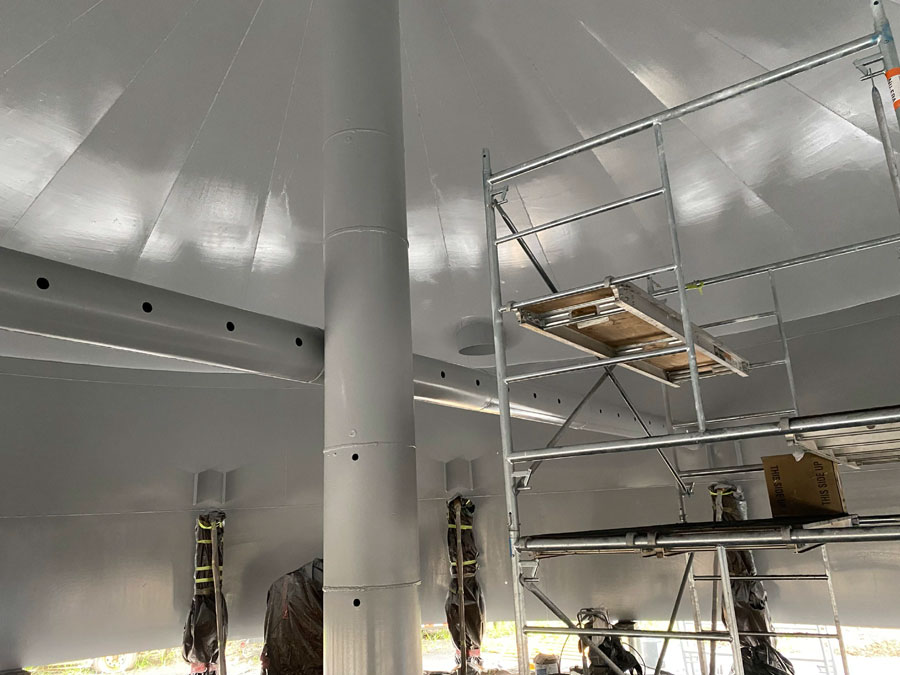
Cost Savings and Environmental Impact
Implementing tank lining systems can lead to significant cost savings and a positive environmental impact for industrial businesses, fostering responsible environmental protection. By reducing the need for frequent maintenance and repairs, effective linings lower overall operational costs while ensuring compliance with environmental standards.
The use of environmentally friendly lining materials can help mitigate the risk of chemical spills and leaks, contributing to safer and cleaner industrial practices and enhancing chemical resistance. This dual benefit is particularly evident in sectors that depend on large storage facilities, such as oil and gas or chemical manufacturing.
For example, waterproofing measures during tank refurbishment not only extend the lifespan of structures but also minimize the risk of environmental contamination. Companies can save substantial amounts by avoiding costly cleanup operations and potential fines associated with regulatory non-compliance, ensuring adherence to regulatory standards.
These proactive strategies promote responsible resource management, further enhancing a company’s reputation and commitment to sustainability and industry best practices. Therefore, leveraging advanced tank lining technologies fosters financial efficiency while reinforcing a dedication to environmental stewardship.
Types of Tank Lining Services
Tank lining services are classified into internal and external applications based on their specific purposes, including surface preparation and tank rehabilitation.
Internal tank lining services aim to protect the interior surfaces of the tank from corrosion and other harmful effects caused by the contents stored within. In contrast, external tank lining services safeguard the tank from atmospheric conditions and various environmental elements.
It is essential to engage only reputable tank service providers for tank lining services to ensure that the correct methodologies and materials are utilized for effective tank restoration, tank repair, and maintenance.
Internal Tank Lining
Internal tank lining is a critical service that involves applying a protective coating to the internal surfaces of storage tanks to optimize chemical resistance and improve the tanks’ integrity and mechanical properties.
Tank epoxy lining and other methods provide long-term protection against corrosive materials; however, substrate preparation and tank cleaning are essential prerequisites to ensure proper adhesion, coating thickness, and durability.
The best results are achieved when tank operators employ thorough cleaning methods, which may include pressure washing and the use of chemical solvents to eliminate surface contaminants and previous coatings. This preparation process also creates a surface profile, which is vital for the effective adhesion of the epoxy lining.
It is important to select the appropriate type of epoxy to ensure protection against the specific chemical exposures that a tank is likely to encounter, allowing the lining to maintain its protective qualities over time. By ensuring proper substrate preparation, adhesion testing, and careful epoxy selection, the overall effectiveness of the tank lining can be significantly enhanced.
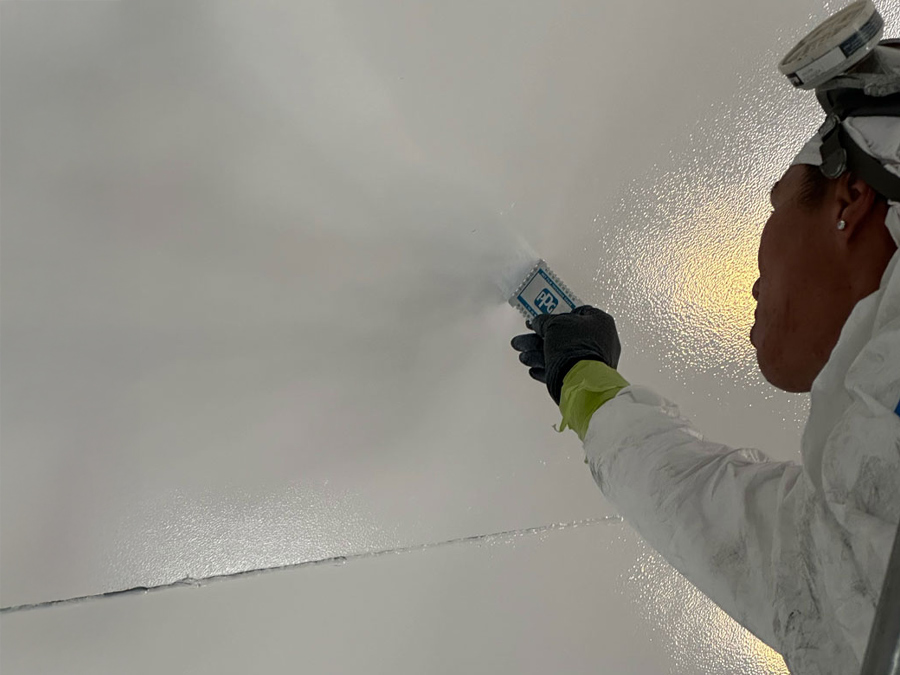
External Tank Lining
External tank lining involves protecting the exteriors of storage tanks from environmental factors, which enhances both safety and reliability, ensuring tank decommissioning protocols are adhered to.
The application of anti-corrosive linings safeguards tanks against rust and other forms of deterioration, ensuring regulatory compliance and reducing the frequency of inspections and repairs. Proper external linings extend the lifespan of tanks and significantly diminish the risk of leaks and failures that could result in catastrophic environmental damage, promoting tank integrity.
Tanks that are adequately lined are better shielded from adverse weather, chemical exposure, physical wear and tear, and thermal insulation issues, contributing to a safer operational environment.
Regular assessments and strict adherence to tank inspection protocols become more manageable, as the effectiveness of the external lining helps to identify potential problems before they escalate, leading to improved leak detection and corrosion analysis.
These factors highlight the importance of external tank lining and emphasize the necessity for proactive maintenance programs, quality assurance, and the implementation of industry best practices.
Choosing the Right Tank Lining Service Provider
When selecting a tank lining service provider, several factors should be considered, including service contracts and project management capabilities. These include the provider’s experience with various tank lining technologies, their compliance with relevant industry standards, their reputation for service quality, and their ability to offer cost-effective solutions.
Providers that emphasize a balanced approach—prioritizing service quality and efficient tank management over merely price-based solutions—tend to be more reliable.
Factors to Consider
When evaluating tank service providers for lining services, several factors should be considered, including regulatory compliance, experience with various tank types, and a commitment to service quality, warranty programs, and efficiency.
A provider’s familiarity with the latest lining technologies and maintenance practices significantly increases the likelihood of achieving positive tank performance outcomes. It is essential to assess their track record with safety regulations, as adherence to environmental and safety standards protects the facility and helps avoid costly downtimes related to legal issues, ensuring substrate compatibility.
For instance, a provider well-versed in the latest EPA standards can help prevent problems associated with non-compliance, providing peace of mind regarding environmental impact. Additionally, experience with specific tank types—whether aboveground, underground, or specialized—plays a critical role in the success of the lining process, benefiting from tailored repair techniques. A provider who regularly services specific tank makes and models can offer valuable knowledge and troubleshooting insights for maintenance tasks.
Furthermore, a commitment to high service quality ensures that all aspects of the lining process are executed to a high standard, resulting in extended tank life, improved operational performance, and customer satisfaction.
The Tank Lining Process
The tank lining process involves a systematic procedure for applying and ensuring the longevity of protective linings in storage tanks, enhancing tank functionality and industry standards. This process includes surface preparation, the application of lining materials, and thorough inspection of the tank to evaluate quality and effectiveness.
The specifics of the tank lining process depend on factors such as the type of tank, the environment in which it operates, its intended usage, and the selected materials, adhering to project timelines and industry trends. Each step is crucial to the overall effectiveness of the tank lining, ensuring coating application techniques are properly executed.
Steps and Techniques Used in Tank Engineering
The steps and techniques involved in tank lining application refer to the methods and procedures that ensure the process is carried out correctly for optimal results. Key steps in the tank lining application include proper substrate preparation, the application of lining materials using advanced techniques, and waterproofing. This process is critical for corrosion prevention and enhancing tank efficiency.
Proper substrate preparation is crucial; the surface on which the lining material will be applied must be clean, dry, and free of contaminants. This preparation is essential to ensure that contaminants do not interfere with the bonding of the lining materials. Substrate preparation may involve cleaning, grinding, or applying a primer. This step is vital for ensuring the durability of the tank coating and lining materials.
Application of lining materials is another critical step in the tank lining process. Selecting the appropriate application technique and lining materials, such as epoxy or polyurea, is essential. Different lining products possess varying properties that can significantly impact their effectiveness and longevity. Material selection and the formulation of the coating are crucial factors in this step.
Advanced techniques may also be employed during the tank lining application. These can include waterproofing methods, such as the application of membranes or sealants, which create secondary barriers to help prevent leakage from the tank. Advanced application techniques, such as spray application or brush techniques, can also be utilized. Each method for applying substrates or lining materials has its own advantages and disadvantages. These techniques are especially relevant in diverse application environments.
The most effective approach for a specific tank and its intended use will depend on factors such as viscosity, desired thickness, and the properties of the lining material.
Ultimately, proper application and waterproofing techniques are vital for ensuring the durability and effectiveness of the tank lining. This ensures the tank’s service life and overall efficiency.
Maintenance and Repair of Tank Lining
Maintaining and repairing tank linings is essential for the overall effectiveness and safety of storage tanks. Regular inspections of tank linings, along with ongoing maintenance and repair practices, enable the early detection of wear and damage. Utilizing skilled labor for these tasks can significantly improve the outcomes.
This proactive approach allows for timely repairs that preserve the integrity of the linings. Adhering to the maintenance practices recommended by manufacturers ensures maximum durability of the linings and enhances the overall safety of the tanks.
Recommended Maintenance Practices
Recommended maintenance practices for tank linings involve regular inspections, thorough cleaning, and timely repairs to ensure optimal performance and safety.
Routine evaluations can reveal early signs of wear or damage, allowing for prompt corrective measures that enhance the longevity of the protective linings. These practices are essential for maintaining safety and ensuring regulatory compliance for the tank.
Establishing a regular inspection timetable can provide peace of mind and help prevent failures. Inspections should include checks on lining thickness, as well as assessments for corrosion or other forms of material degradation.
Regular cleaning is crucial for removing surface contaminants that could lead to deterioration over time. Additionally, maintaining accurate records of maintenance activities can assist in condition assessments and future planning, thereby protecting both the asset and the materials stored within it.
Addressing Common Issues and Repairs
Common problems with tank linings include peeling, cracking, chemical degradation, and improper installation. If these issues are left unaddressed, they can severely impact the overall performance of the tank.
Timely troubleshooting and repairs are essential to prevent further damage, maintain the integrity of the tank lining, and ensure operational safety. Regular inspections play a critical role in identifying issues early on. Employing advanced inspection techniques can further aid in this process.
Visual assessments can reveal signs of distress before they escalate into more significant problems. Consistent maintenance, such as applying protective coatings and monitoring for environmental changes, can enhance lining performance.
When deficiencies are identified, various repair techniques, such as patching or complete re-lining, can be employed based on the extent of the damage. Using the appropriate materials that can withstand the specific liquid or gas stored in the tank can significantly improve the longevity of the lining. The choice of repair technique should also consider tank specifications and the construction of the tank.
Adopting a proactive approach to tank care and maintenance allows for the early identification and resolution of these problems, preventing them from developing into larger issues.
Frequently Asked Questions
What are Tank Lining Services?
Tank Lining Services involve coating the interior surface of a tank with a protective layer to prevent corrosion and leaks. These services also include customizing the tank design to meet specific industrial applications.
Why should I consider Tank Lining Services?
Tank Lining Services can extend the lifespan of your tank, reduce maintenance costs, and ensure safe storage of liquids or chemicals. This can be particularly important for chemical storage and other critical industrial applications.
What types of tanks can be lined?
Tank Lining Services can be applied to various types of tanks including steel, fiberglass, concrete, and plastic tanks. The selection of tank type should consider the intended tank usage and application environments.
How long does it take to complete Tank Lining Services?
The duration of Tank Lining Services varies depending on the size and condition of the tank, but it typically takes a few days to a week to complete. Service solutions can be tailored to minimize downtime and enhance energy efficiency.
Do I need to empty my tank before getting it lined?
Yes, the tank must be emptied and properly cleaned before Tank Lining Services can be applied. This ensures that the coating adheres properly and provides maximum protection.
Is there a warranty for Tank Lining Services?
Most reputable companies offer a warranty for their Tank Lining Services to guarantee the quality of their work. Be sure to inquire about the details and length of the warranty before hiring a company. Performance testing of the applied lining can also be included to ensure compliance with specifications.


